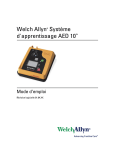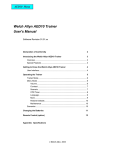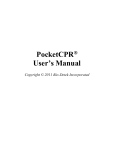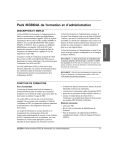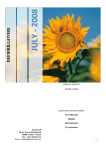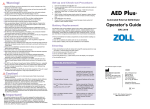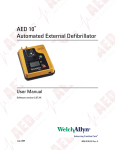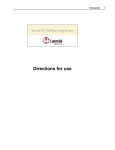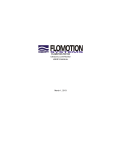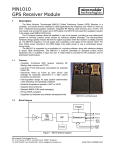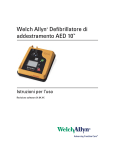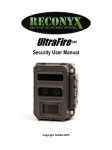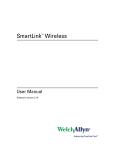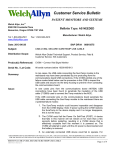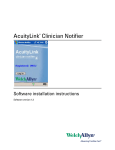Download AED 10 Trainer Manual
Transcript
Welch Allyn AED 10 Trainer ® TM Operating Instructions Software version 01.04.XX ii Welch Allyn AED 10 Trainer © 2009 Welch Allyn. All rights are reserved. No one is permitted to reproduce or duplicate, in any form, this manual or any part thereof without permission from Welch Allyn. Welch Allyn assumes no responsibility for any injury to anyone, or for any illegal or improper use of the product, that may result from failure to use this product in accordance with the instructions, cautions, warnings, or statement of intended use published in this manual. Welch Allyn® is a registered trademark of Welch Allyn. AED 10TM is a trademark of Welch Allyn. Software in this product is Copyright Welch Allyn or its vendors. All rights are reserved. The software is protected by United States of America copyright laws and international treaty provisions applicable worldwide. Under such laws, the licensee is entitled to use the copy of the software incorporated with this instrument as intended in the operation of the product in which it is embedded. The software may not be copied, decompiled, reverse-engineered, disassembled or otherwise reduced to human-perceivable form. This is not a sale of the software or any copy of the software; all right, title and ownership of the software remain with Welch Allyn or its vendors. For information about any Welch Allyn product, call the nearest Welch Allyn representative: USA 1 800 535 6663 + 1 315 685 4560 Canada 1 800 561 8797 Australia + 6129 638 3000 800 074 793 China + 86 216 327 9631 European Call Center + 353 46 906 7790 France + 3315 569 5849 Germany + 49 747 792 7186 Japan + 8133 219 0071 Latin America + 1 305 669 9003 Singapore + 656 419 8100 United Kingdom + 44 207 365 6780 Netherlands + 3115 750 5000 South Africa + 2711 777 7555 Sweden + 46 85 853 6551 Caution! Changes or modifications not expressly approved by Welch Allyn could void the purchaser’s authority to operate the equipment. REF 810-2475-XX Manual Part Number 810-2477-00 Rev B, 10/2009 ZOLL Medical Corporation 269 Mill Road Chelmsford, MA 01824-4105 USA Welch Allyn, inc. 8500 SW Creekside Place Beaverton, Oregon 97008-7107 www.welchallyn.com Printed in USA ZOLL International Holding B.V. Newtonweg 18 6662 PV ELST The Netherlands Operating Instructions 1 Contents Introduction . . . . . . . . . . . . . . . . . . . . . . . . . . . . . . . . . . . . . . . . . . . . . . . . . . . . . . . . . . . . 1 Overview . . . . . . . . . . . . . . . . . . . . . . . . . . . . . . . . . . . . . . . . . . . . . . . . . . . . . . . . . . . 1 Special Features . . . . . . . . . . . . . . . . . . . . . . . . . . . . . . . . . . . . . . . . . . . . . . . . . . . . . 1 Operation . . . . . . . . . . . . . . . . . . . . . . . . . . . . . . . . . . . . . . . . . . . . . . . . . . . . . . . . . . . . . . 3 User Interface . . . . . . . . . . . . . . . . . . . . . . . . . . . . . . . . . . . . . . . . . . . . . . . . . . . . . . . 2 Trainer Mode . . . . . . . . . . . . . . . . . . . . . . . . . . . . . . . . . . . . . . . . . . . . . . . . . . . . . . . . 3 Menu Mode . . . . . . . . . . . . . . . . . . . . . . . . . . . . . . . . . . . . . . . . . . . . . . . . . . . . . . . . 4 Scenarios . . . . . . . . . . . . . . . . . . . . . . . . . . . . . . . . . . . . . . . . . . . . . . . . . . . . . . . . . . . . . . 9 Changing the Batteries . . . . . . . . . . . . . . . . . . . . . . . . . . . . . . . . . . . . . . . . . . . . . . . . . . 10 Remote Control . . . . . . . . . . . . . . . . . . . . . . . . . . . . . . . . . . . . . . . . . . . . . . . . . . . . . . . . 10 Specifications . . . . . . . . . . . . . . . . . . . . . . . . . . . . . . . . . . . . . . . . . . . . . . . . . . . . . . . . . 12 Electromagnetic Compatibility. . . . . . . . . . . . . . . . . . . . . . . . . . . . . . . . . . . . . . . . . . . . . 12 Introduction Overview The Welch Allyn AED 10 Trainer is a training tool for preparing emergency responders to use the Welch Allyn AED 10 defibrillator to treat a victim of sudden cardiac arrest. The Trainer provides realistic simulation of the defibrillator without actually charging or discharging electrical energy. Voice prompts, simulated energy delivery, pauses for CPR, Training Pads, and the functional system status indicator all accurately mimic the operation of the defibrillator and provide a realistic demonstration. • Twelve different scenarios are available. • Multiple language selections are available. • Hand-held IR remote control allows instructors to customize training sessions. The Trainer is intended for indoor use. The Trainer is not intended to teach basic life-saving skills. Trainees should have completed an appropriate training class for knowledge in assessing the patient, CPR (cardiopulmonary resuscitation), and correct medical protocols. Training Pads should be used only with a “plastic skin” type mannequin. Do not use on foam-based mannequins. Note Caution Trainer Pads are for demonstration purposes only and are not for clinical use. Special Features • Voice prompts identical to those in the defibrillator. • Text prompts identical to those in the defibrillator. • Remote control for instructor use. 2 Welch Allyn AED 10 Trainer User Interface 3. Connect cable from defibrillator pads 7. Remote control window (IR) and command status indicator 4. System status indicator 1. ON/OFF button 5. Battery level indicator 2. Shock button 6. Menu buttons 1 Green ON/OFF button Turns the Trainer on and off. 2 Red Shock button Flashes to prompt a simulated shock, and is pressed to deliver a simulated shock. 3 ECG Pad Connector Connect the cable from the pads to the Trainer here. 4 LCD Status Indicator Ready for operation. Do not use the Trainer. Replace the batteries or service the Trainer. Do not use the Trainer. Replace the batteries or service the Trainer. 5 Battery Level Indicator Displays the current battery level. The Trainer displays text and voice prompts when the battery needs to be changed. Note: The Battery Level Indicator is only available on Welch Allyn AED 10 defibrillators using software versions 2.06.02 and earlier. 6 Menu buttons Control volume, contrast, scenario, CPR timer, and language. 7 Remote Control Window and Command Status LED Receives light pulses from the Remote Control.The Command Status LED next to the Remote Control window illuminates when a command is received. Operating Instructions 3 Operation Trainer Mode Trainer mode is the primary mode of operation and is accessed by pressing the green ON/ OFF button. In this mode the Menu buttons are inoperative and all menus are inactive. The ON/OFF button and the Shock button are the only user responsive buttons in this mode. While in Trainer mode the unit displays elapsed time, battery level, number of shocks delivered to the patient, text prompts, and various status messages on the LCD display. Figure 1. Trainer Mode Display Elapsed Time Battery Level Patient Shock Counter AED Text Status Elapsed Time While in Trainer mode the elapsed time is displayed in the upper left hand corner of the screen in the following format: HH:MM:SS. The Elapsed Time stops incrementing if the Trainer is paused during a scenario and continues after the scenario is resumed. Battery Level While in Trainer mode the Trainer graphically displays the battery level in the upper middle portion of the screen. The battery level indicator displays 10 distinct battery levels and is updated every second. The word “LOW” appears under the battery level symbol if the average battery voltage falls below operating levels. Note The Battery Level Indicator is only available on Welch Allyn AED 10 defibrillators using software versions 2.06.02 and earlier. Patient Shock Counter While in Trainer mode the unit displays the number of shocks delivered in the upper right hand corner of the screen AED Text While in Trainer mode this region of the display shows text prompts to the user. Status The lower right hand corner of the screen displays the simulated amount of delivered energy. 4 Welch Allyn AED 10 Trainer Menu Mode Menu mode allows the user to access and set various system parameters. Menu mode is enabled by holding down the lower menu button while turning on the Trainer. Once the Trainer has been powered up into Menu mode the following menu appears on the screen: Figure 2. Menu Mode Display Diagram Soft Key Label 1 Main Menu Menu Title Volume Next Contrast Scenario Menu Buttons Menu Selections CPR Enter Language More Soft Key Label 2 Display Border Volume Pressing the Enter button while the Volume menu item is highlighted causes the Volume menu to be displayed, allowing the user to select a level between 1 and 3. As sound volume values are selected using the Next button, a beep is heard at the selected volume. The Save menu item saves the currently selected value and then returns to the Main Menu. The Cancel menu item restores the volume value that was present prior to entering the Volume menu and returns to the Main Menu. Main Menu Volume Volume 1-3 Enter Save Contrast Cancel Scenario Next Enter Enter Main Menu Main Menu CPR Language More Contrast Pressing the Enter button while the Contrast menu item is highlighted displays the Contrast menu, allowing the user to select a contrast value between 0 and 5. As contrast values are selected using the Next button, the display contrast changes immediately to the selected value. The Save menu item saves the currently selected value and returns to the Main Menu. The Cancel menu item restores the contrast value present prior to entering the Contrast menu and returns to the Main Menu. Main Menu Contrast Volume 0-4 Contrast Scenario CPR Language More Save Enter Cancel Next Enter Enter Main Menu Main Menu Operating Instructions 5 Scenario Pressing the Enter button while the Scenario menu item is highlighted displays the Scenario menu, allowing the user to select different scenarios (see “Scenarios” on page 9 for more details). Pressing the Next button causes a sequential display of possible Scenario numbers, and pressing the Enter button causes the current scenario number to be selected and the Save menu item to be highlighted. Pressing the Enter button while the Save menu item is highlighted stores the currently selected Scenario number and returns to the Main Menu. The Cancel menu item restores the scenario value present prior to entering the Scenario menu and returns to the Main Menu. Main Menu Scenario Volume (see note 1) Contrast Save Scenario Cancel Next Enter Enter Main Menu Main Menu Enter CPR Language Note 1: Press Next to scroll through the scenarios. More The scenarios are numbered sequentially in the same order as for the remote control. Table 1. Training Scenario Menu Selections Scenario Description 3-Shock Protocols 1 AHA Scenario 1 2 AHA Scenario 2 3 AHA Scenario 3 4 AHA Scenario 4 5 AHA Scenario 5 6 AHA Scenario 6 7 AHA Scenario 7 8 AHA Scenario 8 1-Shock Protocols a. 9 Ventricular Fibrillation with one shock conversion 10 Ventricular Fibrillation with one shock conversion followed by refibrillation 11 Shockable Rhythma 12 Non-shockable Rhythma Not accessible through remote control, must be accessed through the Scenario Menu. CPR Pressing the Enter button while the CPR menu item is highlighted displays the CPR menu, with CPR Timer highlighted. Pressing the Next button highlights CPR Tempo, and pressing Next again highlights Back. With CPR Timer highlighted, pressing the Enter button displays the CPR Timer menu. With CPR Tempo highlighted, pressing the Enter button display the CPR Tempo menu. With Back highlighted, pressing the Enter button displays the Main Menu. 6 Welch Allyn AED 10 Trainer Main Menu CPR Volume Enter CPR Timer Contrast CPR Tempo Scenario Back CPR Enter Enter CPR Timer Menu CPR Tempo Menu Main Menu Enter Language More CPR Timer Pressing the Enter button while CPR Timer is highlighted displays the CPR Timer menu, allowing the user to select a CPR time of 15, 30, 45, 60, 75, 90, 120, 150, or 180 seconds. The Save menu item saves the currently selected value and returns to the CPR Menu. The Cancel menu item restores CPR Timer to the previous value and returns to the CPR Menu. CPR Timer CPR CPR Timer Enter CPR Tempo Next 15/30/45/60/75/90/ 120/150/180 Enter Enter Save Enter Back Cancel Save Menu Item CPR Menu CPR Menu CPR Tempo Pressing the Enter button while CPR Tempo is highlighted displays the CPR Tempo menu. CPR Tempo (number of CPR chest compressions per minute) options are 90, 95, 100, 105, 110, 115, 120, or Disable. The Save menu item saves the currently selected value and returns to the CPR Menu. The Cancel menu item restores CPR Tempo to the previous value and returns to the CPR Menu. CPR Tempo CPR CPR Timer CPR Tempo Back 90/95/100/105/110/ 115/120/Disable Enter Save Cancel Next Enter Enter Enter Save Menu Item CPR Menu CPR Menu Operating Instructions 7 Language Pressing the Enter button while the Language menu item is highlighted causes the Language menu to be displayed. The current Language is displayed, and pressing the Next button scrolls through the list of available languages. Each language selection is displayed in its own language as the list is traversed, and pressing the Enter button while the Save menu item is highlighted stores the currently selected language as the new language parameter. All text is subsequently displayed in the new language. Pressing the Enter button while the Cancel menu item is highlighted displays the Main Menu. Next Enter Main Menu Language Volume (See note 2) Contrast Save Enter Scenario Cancel Enter Save Main Menu Main Menu or Reboot Main Menu CPR Language More Enter Note 2: Press Next to scroll through the languages. (Each language is displayed in its own language.) More Pressing the Enter button while the More menu item is highlighted causes the More Menu to be displayed. Main Menu More Menu Volume Restore Defaults Contrast Maintenance Scenario Back Enter Main Menu CPR Language More Enter Restore Defaults Pressing the Enter button while the Restore Default menu item is highlighted displays the restore defaults menu. Pressing the Next button scrolls down, highlighting the next menu item. If the Enter button is pressed while the Yes menu item is highlighted, all of the configuration parameters are forced to their default value except for the language. If the Enter button is pressed while the Cancel menu item is highlighted the More Menu is displayed. More Menu Restore Defaults Restore Defaults Yes Maintenance Back Enter Cancel Enter Enter Reboot More Menu 8 Welch Allyn AED 10 Trainer Maintenance Pressing the Enter button while the Maintenance menu item is highlighted displays the Maintenance Menu. This menu is for factory use only. More Menu Maintenance Restore Defaults System Test Maintenance Back Enter Service Debug External Debug Back Enter More Menu Operating Instructions 9 Scenarios The Trainer provides training scenarios that follow the American Heart Association (AHA) recommended AED training scenarios. These scenarios are preconfigured and give an AED Instructor a standard means of training and testing proficiency in AED use. Scenarios 1 to 10 may be selected with the Menu Mode Scenario menu or with the Remote Control. Scenarios 1 to 8 conform to the AHA recommended training scenarios. Scenario 9 is the same as AHA scenario 2 except with a one shock conversion. Scenario 10 is the same as AHA scenario 7 except with a one shock conversion followed by refibrillation. The Scenario menu may also be used to select a continuous Shockable rhythm (11) or a continuous Non-shockable rhythm (12). Table 2. Training Scenarios Description Event 1 Event 2 Event 3 Event 4 Event 5 Event 6 3-Shock Protocols 1 Ventricular fibrillation with four-shock conversion Shockable rhythm 3 Shocks CPR Shockable rhythm 1 Shock Nonshockable rhythm 2 Ventricular fibrillation with two-shock conversion Shockable rhythm 2 Shocks Nonshockable rhythm CPR Nonshockable rhythm CPR 3 Ventricular fibrillation with two-shock conversion Shockable rhythm 2 Shocks Nonshockable rhythm CPR Nonshockable rhythm CPR 4 Non-shockable rhythm Nonshockable rhythm CPR Nonshockable rhythm CPR Nonshockable rhythm CPR 5 Ventricular fibrillation with four-shock conversion Shockable rhythm 3 Shocks CPR Shockable rhythm 1 Shock Nonshockable rhythm 6 Non-shockable rhythm Nonshockable rhythm CPR Nonshockable rhythm CPR Nonshockable rhythm CPR 7 Ventricular fibrillation with two-shock conversion followed by refibrillation Shockable rhythm 2 Shocks Nonshockable rhythm Shockable rhythm 1 Shock Nonshockable rhythm 8 Troubleshooting skills defibrillator pads followed by two-shock conversion Pad fault Shockable rhythm 2 Shocks Nonshockable rhythm CPR Nonshockable rhythm 1-Shock Protocols 9 Ventricular fibrillation with one-shock conversion Shockable rhythm 1 Shock CPR Nonshockable rhythm CPR Nonshockable rhythm 10 Ventricular fibrillation with one-shock conversion followed by refibrillation Shockable rhythm 1 Shock CPR Nonshockable rhythm CPR Shockable rhythm 11 Continuous ventricular fibrillation Shockable rhythm 1 Shock CPR Shockable rhythm 1 Shock CPR 12 Continuous non-shockable rhythm Nonshockable rhythm CPR Nonshockable rhythm CPR Nonshockable rhythm CPR 10 Welch Allyn AED 10 Trainer Changing the Batteries 1. Remove the four screws on the back panel. 2. Remove the panel. 3. Replace all batteries at the same time with 6 C-cell alkaline batteries. After battery replacement, the status indicator will flash until the unit is powered on. 4. Replace the back panel and insert the four screws. Remote Control The hand-held remote control for the Trainer provides the Instructor with significant control over the configuration of the Trainer. The remote control communicates with the Trainer via an IR window located next to the PADs connector. A status indicator LED is located next to the IR window, and it will flash to indicate that a command has been received. The status indicator LED will flash continuously when a scenario has been paused. Refer to the diagram and descriptions listed below. 1 2 3 4 5 6 7 8 9 10 Note: The remote control battery access is located on the back side of the remote control. To open the battery compartment, slide the tab on the right side to the left and pull the compartment away from the remote. Replace the 3V Lithium (CR2025) battery positive side up. Table 3. Remote Control Buttons 3-Shock Protocols 1 Allows the Instructor to select AHA Scenario number 1 as the default scenario. The Trainer will automatically turn off after the selection has been made. 2 Allows the Instructor to select AHA Scenario number 2 as the default scenario. The Trainer will automatically turn off after the selection has been made. Operating Instructions 11 Table 3. Remote Control Buttons (continued) 3 5 7 Allows the Instructor to select AHA Scenario number 3 as the default scenario. The Trainer will automatically turn off after the selection has been made. Allows the Instructor to select AHA Scenario number 5 as the default scenario. The Trainer will automatically turn off after the selection has been made. Allows the Instructor to select AHA Scenario number 7 as the default scenario. The Trainer will automatically turn off after the selection has been made. 4 6 8 Allows the Instructor to select AHA Scenario number 4 as the default scenario. The Trainer will automatically turn off after the selection has been made. Allows the Instructor to select AHA Scenario number 6 as the default scenario. The Trainer will automatically turn off after the selection has been made. Allows the Instructor to select AHA Scenario number 8 as the default scenario. The Trainer will automatically turn off after the selection has been made. 1-Shock Protocols 9 Allows the Instructor to select Ventricular Fibrillation with oneshock conversion. The Trainer will automatically turn off after the selection has been made. 10 Allows the Instructor to select Ventricular Fibrillation with oneshock conversion followed by refibrillation. The Trainer will automatically turn off after the selection has been made. Note: Scenarios 11 and 12 are not accessible through remote control, and must be accessed through the Scenario Menu. Current Scenario Shock Protocols Allows the Instructor to interrupt any scenario with a continuous shockable rhythm. The current default scenario is not changed. Allows the Instructor to interrupt any scenario with a continuous non-shockable rhythm. The current default scenario is not changed. Other Functions Allows the Instructor to interrupt any scenario with a lead-fault condition. To resume the scenario, press the button again. Allows the Instructor to interrupt any scenario with a “Motion” condition on the next rhythm analysis. Allows the Instructor to interrupt any scenario with a Low Battery condition. To resume the scenario, press the button again. Allows the Instructor to simulate a Warning (flashing icon) system status. To resume the scenario, press the button again. Allows the Instructor to pause during any scenario. To resume the scenario, press the button again. While the Trainer is paused, all other buttons are inactive until the pause button has been pressed again. 12 Welch Allyn AED 10 Trainer Specifications Batteries (Trainer) 6 x 1.5V C/LR14 Battery life (Trainer) Approximately 40 hours Battery (remote control) 3V Lithium (CR2025) Battery life (remote control) Approximately two years Number of training scenarios 12 Storage temperature without batteries -22°F to 158°F (-30°C to 70°C) Operating temperature 32°F to 122°F (0°C to 50°C) Weight without batteries 1.5 lb (1.0 kg) Weight with batteries 2.5 lb (1.6 kg) Dimensions 8.25 X 6.875 X 2.75 in (210 X 175 X 70 mm) Electromagnetic Compatibility Category Standard Level Radiated emissions EN55011 CISPR 11 B ESD EN61000-4-2 8KV air 6KV contact Radiated Susceptibility EN61000-4-3 10 V/m (20 V/m EN 60601-2-4) Guidance and manufacturer’s declaration: Electromagnetic emissions (IEC 60601-1-2 Table 201) The Welch Allyn AED 10 Trainer is intended for use in the electromagnetic environment specified below. The customer or the user of the Welch Allyn AED 10 Trainer should assure that it is used in such an environment. Emissions test Compliance Electromagnetic environment - Guidance RF emissions CISPR 11 Group 1 RF emissions CISPR 11 Group B The Welch Allyn AED 10 Trainer uses RF energy only for its internal function. Therefore, its RF emissions are very low and are not likely to cause any interference in nearby electronic equipment. Harmonic emission IEC 61000-3-2 Not applicable Voltage fluctuation/flicker emissions IEC 61000-3-3 Not applicable Medical Electrical Equipment needs special precautions regarding EMC and needs to be installed and put into service according to EMC information provided in this document. Operating Instructions 13 Guidance and manufacturer’s declaration: Electromagnetic immunity (IEC 60601-1-2 Table 202) The Welch Allyn AED 10 Trainer is intended for use in the electromagnetic environment specified below. The customer or the user of the Welch Allyn AED 10 Trainer should assure that it is used in such an environment. Immunity Test IEC 60601 test level Compliance level Electrostatic discharge (ESD) IEC 61000-4-2 ± 6 kV contact ± 8 kV air ± 6 kV contact Floors should be wood, concrete ± 8 kV air or ceramic tile. If floors are covered with synthetic material, the relative humidity should be at least 30%. Electrical fast transient/ burst IEC 61000-4-4 ± 2 kV for power supply lines ± 1 kV for input/output lines Not applicable Not applicable Surge IEC 61000-4-5 ± 1 kV differential mode +/- 2 kV common mode Not applicable Not applicable Voltage dips, short interruptions and voltage variations on power supply input lines. IEC 61000-4-11 <5% UT (>95% dip in UT) for 0.5 cycle 40% UT (60% dip in UT) for 5 cycles 70% UT (30% dip in UT) for 25 cycles <5% UT (>95% dip in UT) for 5 sec (UT is the a.c. mains voltage prior to application of the test level.) Not applicable Not applicable Not applicable Not applicable Power frequency (50/60 Hz) 3 A/m magnetic field IEC 61000-4-8 Electromagnetic environment - Guidance Not applicable Power frequency magnetic fields should be at levels characteristic of a typical location in a typical commercial or hospital environment 14 Welch Allyn AED 10 Trainer Guidance and manufacturer’s declaration: Electromagnetic immunity (IEC 60601-1-2 Table 203) The Welch Allyn AED 10 Trainer is intended for use in the electromagnetic environment specified below. The customer or the user of the Welch Allyn AED 10 Trainer should assure that it is used in such an environment. Immunity Test IEC 60601 test level Compliance Electromagnetic environment level Guidance Portable and mobile RF communications equipment should be used no closer to any part of the Welch Allyn AED 10 Trainer, including cables, than the recommended separation distance calculated from the equation applicable to the frequency of the transmitter. Recommended separation distance Conducted RF IEC 61000-4-6 Radiated RF IEC 61000-4-3 3 Vrms 150 kHz to 80 MHz outside ISM bandsa 3 Vrms d = 1.17 * P 10 Vrms 150 kHz to 80 MHz in ISM bandsa 10 Vrms d = 1.20 * P 10 V/m 80 MHz to 2.5 GHz 10 V/m d = 1.20 * P 80 MHz to 800 MHz d = 2.30 * P 800 MHz to 2.5 GHz where P is the maximum output power rating of the transmitter in watts (W) according to the transmitter manufacturer and d is the recommended separation distance in meters (m).b Field strengths from fixed RF transmitters, as determined by an electromagnetic site survey,c should be less than the compliance level in each frequency range.d Interference may occur in the vicinity of equipment marked with the symbol: NOTE 1 At 80 MHz and 800 MHz, the higher frequency range applies. NOTE 2 These guidelines may not apply in all situations. Electromagnetic propagation is affected by absorption and reflection from structures, objects and people. a. b. c. d. The ISM (industrial, scientific and medical) bands between 150 KHz and 80 MHz are 6.765 MHz to 6.795 MHz; 13.553 MHz to 13.567 MHz; 26.957 MHz to 27.283 MHz; and 40.66 MHz to 40.70 MHz. The compliance levels in the ISM frequency bands between 150 kHz and 80 MHz and in the frequency range 80 MHz to 2.5 GHz are intended to decrease the likelihood that mobile/portable communications equipment could cause interference if it is inadvertently brought into patient areas. For this reason, an additional factor of 10/3 is used in calculating the recommended separation distance for transmitters in these frequency ranges. Field strengths from fixed transmitters, such as base stations for radio (cellular/cordless) telephones and land mobile radios, amateur radio, AM and FM radio broadcast and TV broadcast cannot be predicted theoretically with accuracy. To assess the electromagnetic environment due to fixed RF transmitters, an electromagnetic site survey should be considered. If the measured field strength in the location in which the Welch Allyn AED 10 Trainer is used exceeds the applicable RF compliance level above, the Welch Allyn AED 10 Trainer should be observed to verify normal operation. If abnormal performance is observed, additional measures may be necessary, such as reorienting or relocating the Welch Allyn AED 10 Trainer. Over the frequency range 150 kHz to 80 MHz, field strengths should be less than 3V/m. Operating Instructions 15 Recommended separation distances between portable and mobile RF communications equipment and the Welch Allyn AED 10 Trainer (IEC 60601-1-2 Table 205) The Welch Allyn AED 10 Trainer is intended for use in an environment in which radiated RF disturbances are controlled. The customer or the user of the Welch Allyn AED 10 Trainer can help prevent electromagnetic interference by maintaining a minimum distance between portable and mobile RF communications equipment (transmitters) and the Welch Allyn AED 10 Trainer as recommended below, according to the maximum output power of the communications equipment. Separation distance (m) according to frequency of transmitter Rated maximum output power (W) of transmitter 150 kHz to 80 MHz outside ISM bands 150 kHz to 80 MHz in ISM bands 80 MHz to 800 MHz 800MHz to 2.5 GHz d = [ 3.5/3 ] * P d = [ 12/10 ] * P d = [ 12/10 ] * P d = [ 23/10 ] * P 0.01 0.17 0.12 0.12 0.23 0.1 0.37 0.38 0.36 0.73 1 1.17 1.20 1.20 2.3 10 3.69 3.79 3.79 7.27 100 11.70 12.00 12.00 23.00 For transmitters rated at a maximum output power not listed above, the recommended separation distance d in meters (m) can be determined using the equation applicable to the frequency of the transmitter, where P is the maximum output power rating of the transmitter in watts (W) according to the transmitter manufacturer. Note 1: At 80 MHz and 800 MHz, the separation distance for the higher frequency range applies. Note 2: The ISM (industrial, scientific and medical) bands between 150 kHz and 80 MHz are 6.765 MHz to 6.795 MHz; 13.553 MHz to 13.567 MHz; 26.957 MHz to 27.283 MHz; and 40.66 MHz to 40.70 MHz. Note 3: An additional factor of 10/3 is used in calculating the recommended separation distance for transmitters in the ISM frequency bands between 150 kHz and 80 MHz and in the frequency range 80 MHz to 2.5 GHz to decrease the likelihood that mobile/portable communications equipment could cause interference if it is inadvertently brought into patient areas. Note 4: These guidelines may not apply in all situations. Electromagnetic propagation is affected by absorption and reflection from structures, objects and people. 16 Welch Allyn AED 10 Trainer


















